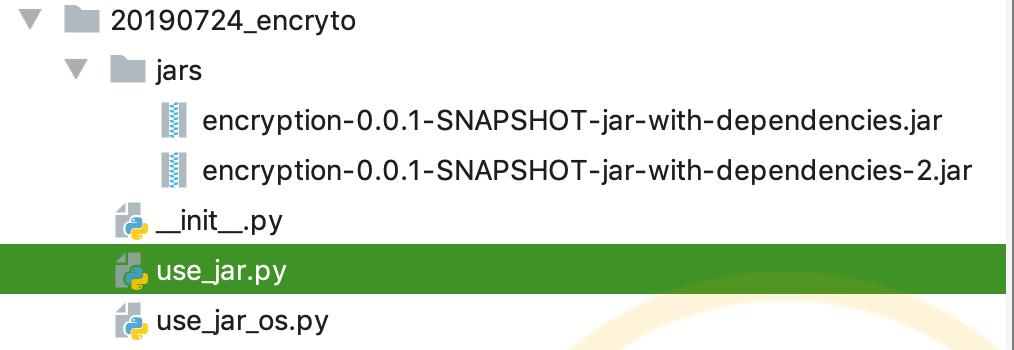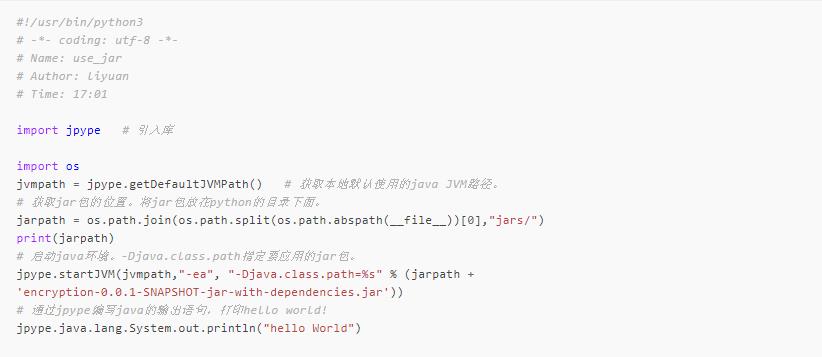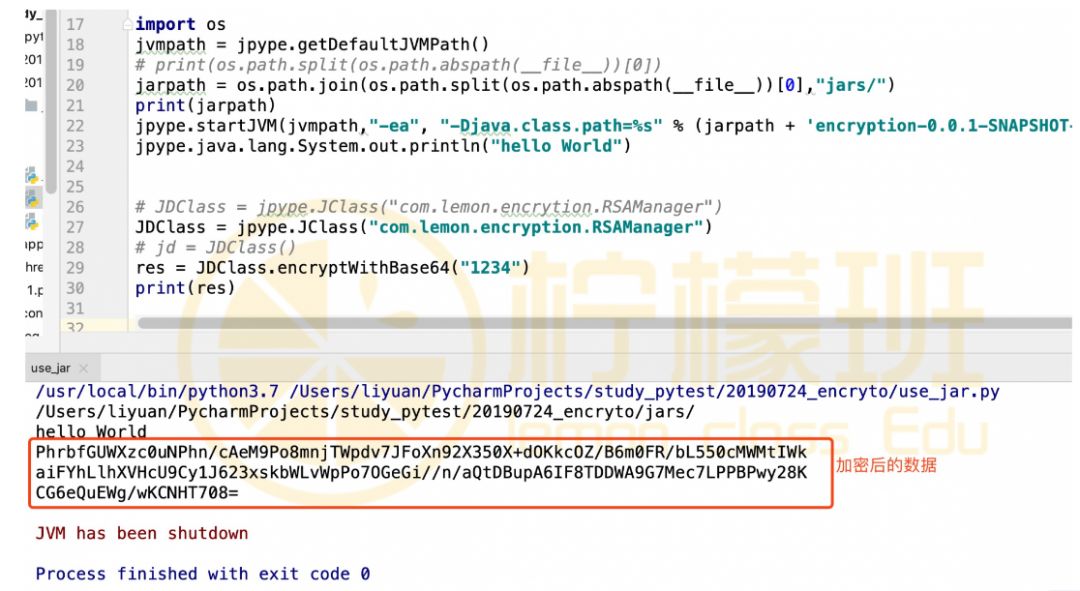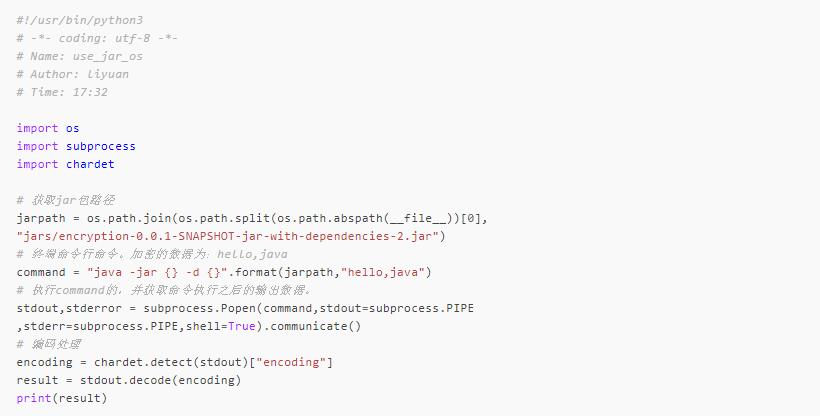一个php加密方法,怎么用java实现,高分!
Posted
tags:
篇首语:本文由小常识网(cha138.com)小编为大家整理,主要介绍了一个php加密方法,怎么用java实现,高分!相关的知识,希望对你有一定的参考价值。
最近做一个php项目的改写,里面有个调第三方webservices用到的加密方法,怎么样用java来实现它。
php代码:
function getSecureString($s)
$key = pack("H*" , '145b206c283b3c534a3822454c313a4f');
$iv = pack("H*" , '343c232c2a1b123d');
$encrypted = openssl_encrypt($s, 'bf-cbc', $key, OPENSSL_RAW_DATA, $iv);
$encryptedString = base64_encode($encrypted);
return $encryptedString;
好像里面的openssl_encrypt方法,我在网上找都找不到,不知道内部是怎么实现的。
第三方又是老外,交流不来,给了我文档,里面也没有提到这个加密原理。
50分求解答!答案解决了加50分
bf-cbc的加密方式,求java实现代码,跪求啊,快被逼疯
Java OpenSSLPBEInputStream
import java.io.IOException;
import java.io.InputStream;
import java.security.InvalidAlgorithmParameterException;
import java.security.InvalidKeyException;
import java.security.NoSuchAlgorithmException;
import java.security.spec.InvalidKeySpecException;
import javax.crypto.BadPaddingException;
import javax.crypto.Cipher;
import javax.crypto.IllegalBlockSizeException;
import javax.crypto.NoSuchPaddingException;
public class OpenSSLPBEInputStream extends InputStream
private final static int READ_BLOCK_SIZE = 64 * 1024;
private final Cipher cipher;
private final InputStream inStream;
private final byte[] bufferCipher = new byte[READ_BLOCK_SIZE];
private byte[] bufferClear = null;
private int index = Integer.MAX_VALUE;
private int maxIndex = 0;
public OpenSSLPBEInputStream(final InputStream streamIn, String algIn, int iterationCount, char[] password)
throws IOException
this.inStream = streamIn;
try
byte[] salt = readSalt();
cipher = OpenSSLPBECommon.initializeCipher(password, salt, Cipher.DECRYPT_MODE, algIn, iterationCount);
catch (Exception e)
throw new IOException(e);
@Override
public int available() throws IOException
return inStream.available();
@Override
public int read() throws IOException
if (index > maxIndex)
index = 0;
int read = inStream.read(bufferCipher);
if (read != -1)
bufferClear = cipher.update(bufferCipher, 0, read);
if (read == -1 || bufferClear == null || bufferClear.length == 0)
try
bufferClear = cipher.doFinal();
catch (Exception e)
bufferClear = null;
if (bufferClear == null || bufferClear.length == 0)
return -1;
maxIndex = bufferClear.length - 1;
if (bufferClear == null || bufferClear.length == 0)
return -1;
return bufferClear[index++] & 0xff;
private byte[] readSalt() throws IOException
byte[] headerBytes = new byte[OpenSSLPBECommon.OPENSSL_HEADER_STRING.length()];
inStream.read(headerBytes);
String headerString = new String(headerBytes, OpenSSLPBECommon.OPENSSL_HEADER_ENCODE);
if (!OpenSSLPBECommon.OPENSSL_HEADER_STRING.equals(headerString))
throw new IOException("unexpected file header " + headerString);
byte[] salt = new byte[OpenSSLPBECommon.SALT_SIZE_BYTES];
inStream.read(salt);
return salt;
Java OpenSSLPBEOutputStream
import java.io.IOException;import java.io.OutputStream;
import java.security.SecureRandom;
import javax.crypto.Cipher;
public class OpenSSLPBEOutputStream extends OutputStream
private static final int BUFFER_SIZE = 5 * 1024 * 1024;
private final Cipher cipher;
private final OutputStream outStream;
private final byte[] buffer = new byte[BUFFER_SIZE];
private int bufferIndex = 0;
public OpenSSLPBEOutputStream(final OutputStream outputStream, String algIn, int iterationCount,
char[] password) throws IOException
outStream = outputStream;
try
/* Create and use a random SALT for each instance of this output stream. */
byte[] salt = new byte[OpenSSLPBECommon.SALT_SIZE_BYTES];
new SecureRandom().nextBytes(salt);
cipher = OpenSSLPBECommon.initializeCipher(password, salt, Cipher.ENCRYPT_MODE, algIn, iterationCount);
/* Write header */
writeHeader(salt);
catch (Exception e)
throw new IOException(e);
@Override
public void write(int b) throws IOException
buffer[bufferIndex] = (byte) b;
bufferIndex++;
if (bufferIndex == BUFFER_SIZE)
byte[] result = cipher.update(buffer, 0, bufferIndex);
outStream.write(result);
bufferIndex = 0;
@Override
public void flush() throws IOException
if (bufferIndex > 0)
byte[] result;
try
result = cipher.doFinal(buffer, 0, bufferIndex);
outStream.write(result);
catch (Exception e)
throw new IOException(e);
bufferIndex = 0;
@Override
public void close() throws IOException
flush();
outStream.close();
private void writeHeader(byte[] salt) throws IOException
outStream.write(OpenSSLPBECommon.OPENSSL_HEADER_STRING.getBytes(OpenSSLPBECommon.OPENSSL_HEADER_ENCODE));
outStream.write(salt);
Main Class 测试以上两个class
import javax.crypto.Cipher;import javax.crypto.NoSuchPaddingException;
import javax.crypto.SecretKey;
import javax.crypto.SecretKeyFactory;
import javax.crypto.spec.PBEKeySpec;
import javax.crypto.spec.PBEParameterSpec;
import java.security.InvalidAlgorithmParameterException;
import java.security.InvalidKeyException;
import java.security.NoSuchAlgorithmException;
import java.security.spec.InvalidKeySpecException;
class OpenSSLPBECommon
protected static final int SALT_SIZE_BYTES = 8;
protected static final String OPENSSL_HEADER_STRING = "Salted__";
protected static final String OPENSSL_HEADER_ENCODE = "ASCII";
protected static Cipher initializeCipher(char[] password, byte[] salt, int cipherMode,
final String algorithm, int iterationCount) throws NoSuchAlgorithmException, InvalidKeySpecException,
InvalidKeyException, NoSuchPaddingException, InvalidAlgorithmParameterException
PBEKeySpec keySpec = new PBEKeySpec(password);
SecretKeyFactory factory = SecretKeyFactory.getInstance(algorithm);
SecretKey key = factory.generateSecret(keySpec);
Cipher cipher = Cipher.getInstance(algorithm);
cipher.init(cipherMode, key, new PBEParameterSpec(salt, iterationCount));
return cipher;
来源引用
https://github.com/guardianproject/ChatSecureandroid/tree/master/src/info/guardianproject/otr
参考技术A 先找出来是什么算法,JAVA 里面的现成的算法还是较多的。看加密的方法,应该是 blowfish 请百度 还是较容易找到的 blowfish JAVA 实现
接口测试时遇到Java代码加密请求数据,用Python的我该怎么办?
前言
自动化测试应用越来越多了,尤其是接口自动化测试。
在接口测试数据传递方面,很多公司都会选择对请求数据进行加密处理。
而目前为主,大部分公司的产品都是java语言实现的。所以加密处理也是java实现的。
作为用python做测试的我,要做接口自动化时,如何去对请求数据进行加密呢?
解决方法
基于此,首先去找开发了解一下具体的加密过程,甚至可以画一个加密流程图出来。
一种方法是:用python代码去实现加密流程。
对测试人员技术能力有所要求,对加密的实现也需要与开发人员密切进行交流。
另外一种便捷的方法就是:直接用python语言调java的加密方式,得到加密后的数据。
这种方式的好处:不用管加密的过程。只要知道如何调用、怎么传加密数据,怎么得到加密后的数据就可以。
调用Java加密代码-方式一
使用python语言调用java加密代码—方式一
此处感谢歪歪大佬提供了java版加密代码。
本篇文章中,歪歪大佬角色:开发GG
1、了解需要用到的加密信息
而我作为测试MM((有一点java基础的)做的第一件事情就是:
愉快的和开发GG聊起了天,咨询了在Java的加密方式中,调用哪个函数可以实现数据加密
第二件事情,就是让开发GG给我打了一个jar包。
这样我用python代码直接调用jar包里的函数就可以了。
2、开始编写python代码,调用java包里的加密函数
python是胶水语言,可以与很多语言一起使用。
python3有个第三方库Jpype1
将开发提供的jar包放在py工程的目录下面。

python代码如下(看每一行代码的注释哦):


运行此段代码之后,对数据1234的加密结果为:

调用Java加密代码-方式二
使用python语言调用java加密代码—方式二
在完成以上操作之后,我又开始和开发GG聊了起来。
问了一句,我可以直接给jar包传参吗?不用去调用java的函数,在调用jar包的同时 给它传参,直接得到加密后的数据?
开发GG说,可以!
等我改一下,我重新发一个jar给你。
于是,5分钟后,开发GG甩了我一个新的jar包,告诉我使用方式。
我又愉快的开启了第二种使用模式。
使用方式是这样的:
在命令行当中使用java命令行:java -jar jar包 -d 要加密的数据。
命令行输出的就是加密后的数据了。
我在命令行试了一下,果真如此:

于是,我转换成了python代码
(需要获取命令行执行的结果,所以要用到subprocess模块):

执行结果如下:

综上,当我们在用python遇到java加密的时候。
可以使用以上2种方式来利用java加密得到加密后的数据。
当然,在这个过程中,我也会遇到问题。
当有问题时,我会向开发GG咨询,因为从启动JVM之后,都是java了,运行出错了或者整不明白的,我都会向开发GG请教。
所以,在工作当中有什么问题,自己查资料的基础上,多与相关人员进行沟通,带着具体的问题去沟通和请教。
希望大家也可以多多有自己解决问题的能力。
本文由柠檬班小简老师原创,转载需注明出处!

让软件测试学习变得更简单!

今日问题
Java如何面向对象编程?
想知道答案吗?
扫描即可解锁解题视频

来都来了,点个在看再走吧~~~
以上是关于一个php加密方法,怎么用java实现,高分!的主要内容,如果未能解决你的问题,请参考以下文章